COVER STORY:
Folk Art in Silicon Valley: Exhibition of Traditional Indian Textiles
These twentieth century folk textiles, collected with an appreciation for the beauty of design and craftsmanship, are on display at the San Jose Museum of Quilts & Textiles. They demonstrate the wealth of the Indian folk tradition, showcasing colorful and tactile variety of decorated textiles, created with patchwork, embroidery, applique, tie dye, block printing, hand sewing and more, writes Julius Berman.
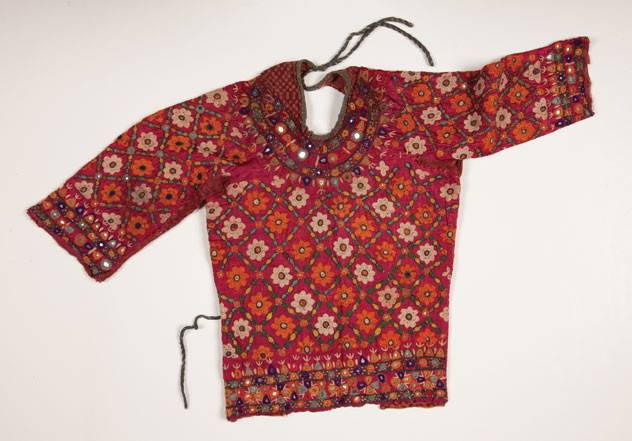
(Above): Choli (blouse) — Rabari, Rajasthan — Cotton, silk, mirrors — Embroidery, 16” x 18”. [Photo: San Jose Museum of Quilts & Textiles]
The San Jose Museum of Quilts and Textiles has a new exhibit — Folk Indian Textiles from the Collection of Carol Summers, on view now through April 28, in the heart of historic downtown San Jose’s SoFA Arts District.
The exhibit encompasses two large galleries plus additional space in the hall leading into the galleries. The first gallery showcases a variety of textiles used in everyday and festive occasions, including richly embroidered kantha cloths from the region of Bengal, clothing (shawls, dresses, children’s garments, bags), animal trappings (camel and bull covers and decorations), and a wall-sized banner once used to decorate outdoor festival pavilions. The second gallery emphasizes textiles used in a ritual context, including dowry pieces of densely embroidered wedding shawls called phulkaris. A highlight of this gallery is the red wall, adorned with five 19th century kanduri cloths, used as offerings to the tomb of 11th century Muslim prince Salar Masud in Bahraich, U.P., a place sacred to Muslims and Hindus alike. These appliquéd kanduri cloths glow with the patina of age and are some of the most unusual textiles in the exhibit.
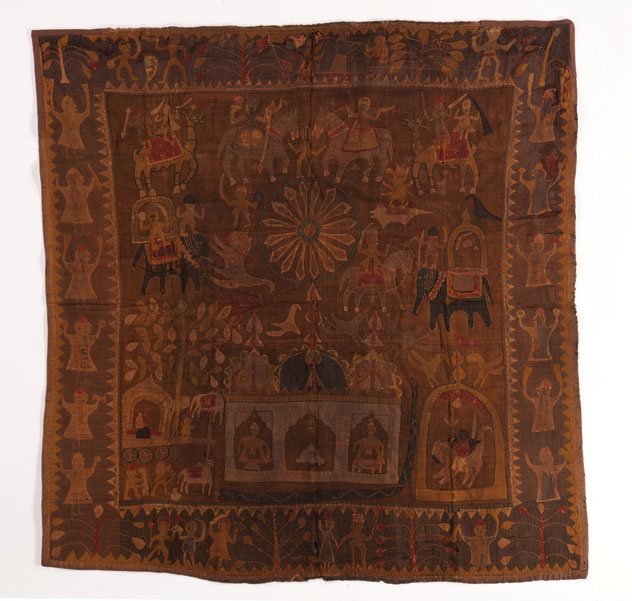
(Above): Kanduri Cloth — Varley, Uttar Pradesh — cotton, applique. [Photo: San Jose Museum of Quilts & Textiles]
Santa Cruz printmaker Carol Summers amassed his collection of Indian textiles over the course of many trips between 1974 and 2012. While conducting woodcut workshops at universities and art schools in India in the 1970s, Summers became enchanted by Indian folk arts and their rich textile heritage. Much of the collection was acquired in the states of Rajasthan and Gujarat in India, as well as Sindh Province in Pakistan and others. The collection represents the Rabari, Banjara, and Muslim communities, among others Summers has encountered in his travels.
The folk textiles he found there not only exhibit a unique love of color and playfulness in varying tradition, but also pay homage to the talent and spirit of the Indian women (and men) who fashioned them. Since 1993, Summers has led tours of India, mainly Rajasthan, focusing on folk arts and the palaces of the Rajputs. He has published three full color catalogs from his collection, A Treasury of Indian Folk Textiles and Another Treasury of Indian Folk Textiles. The third catalog, Yet Another Treasury of Indian Folk Textiles, contains images from his most recent trip to India in January of 2013. The three catalogs are available for sale in the museum shop. Summer’s collection has been exhibited in galleries and museums locally and nationally but this is the first time so much of his collection —over 50 textiles and objects is on display.
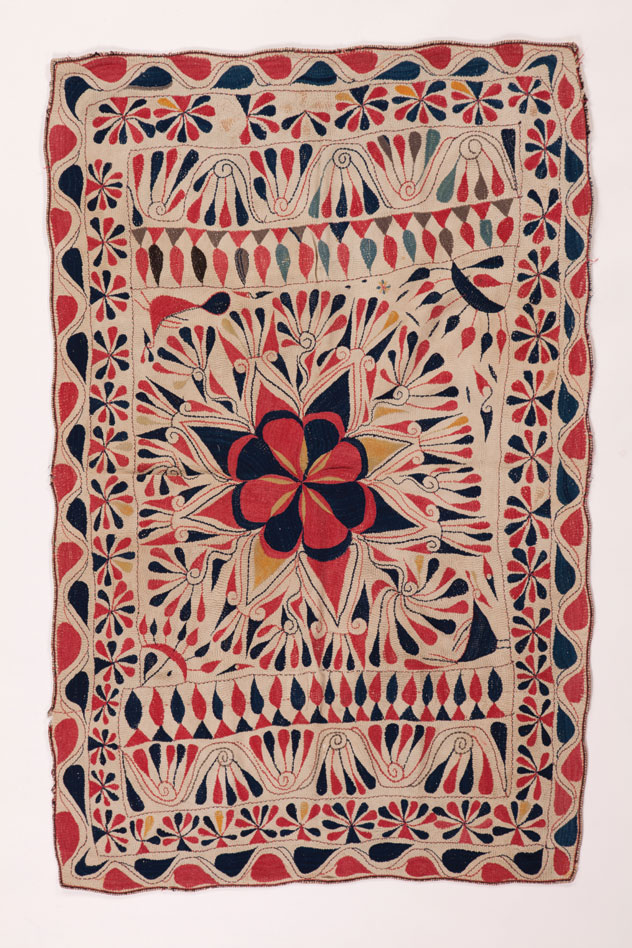
(Above): Kantha cloth, 20th century — Bengal or Bihar — Cotton, made from worn out dhotis (men’s clothing) — 54” x 35”. [Photo: San Jose Museum of Quilts & Textiles]
With their imaginative use of stitching, color, texture, and expressive patterning, these works were collected with an artist’s appreciation for the beauty of design and craftsmanship rather than perfection. These were the utilitarian objects used every day and show the signs of weather and wear and tear from years of use and appreciation. A delicate silk cover embroidered with a scene of the Rasa Lila was apparently used at weddings to hide gifts of cash among trays of food, as evidenced by the remaining stains.
We invite you to feast your eyes on the brightly colored fabrics, excessively decorated and adorned with mirrors, tassels, and other embellishments. Up close, floral and animal motifs, scenes from Vedic scriptures and folktales, geometric patterns, and abstract designs are beautifully executed in a variety of techniques including patchwork, appliqué, embroidery, tie dye, block printing, cloth painting, quilting, hand weaving, and sewing.
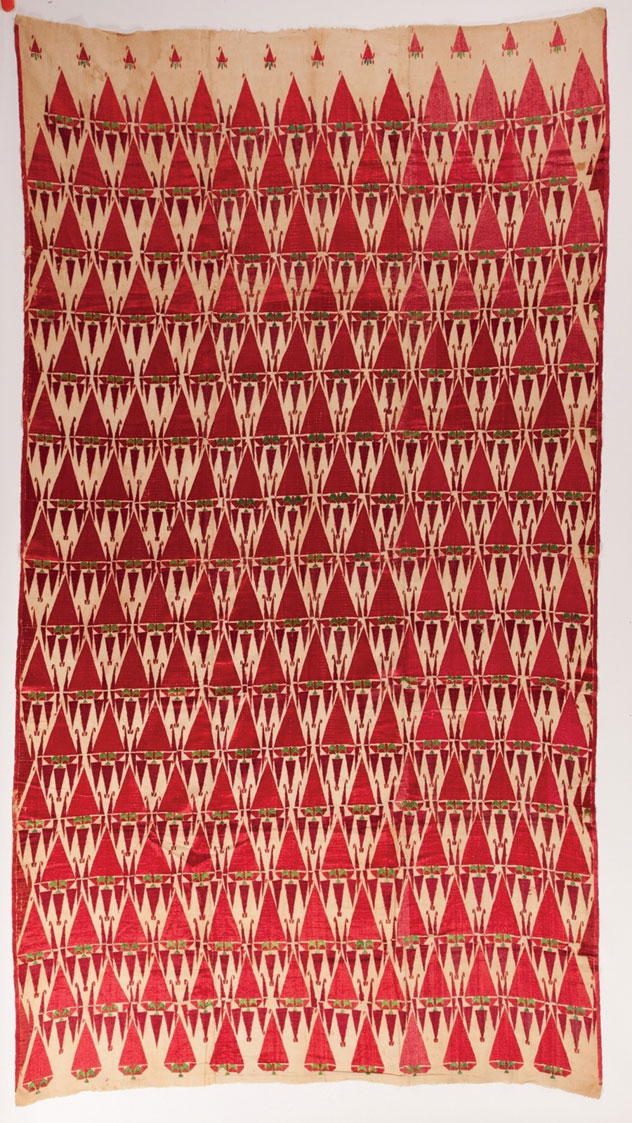
(Above): Phulkari — Silk embroidery on cotton — 98” x 54.5”. [Photo: San Jose Museum of Quilts & Textiles]
These Indian folk textiles showcase the creativity and skill of unknown craftspeople, and highlight the importance of decorative arts in the daily life, festivals, and spiritual practices of this multifaceted culture.
The Museum of Quilts & Textiles was the first museum in the United States dedicated to quilts and textiles as an art form. In 2005 San Jose Mercury News named the Museum one of the top 10 attractions in San Jose. Hours: 10:00am-5:00pm Wednesday through Sunday; closed Mondays, Tuesdays and major holidays. Admission: $8.00 general; $6.50 students and seniors; and free to Museum members and children under 13. Admission is ‘pay what you can’ on the first Friday of each month.
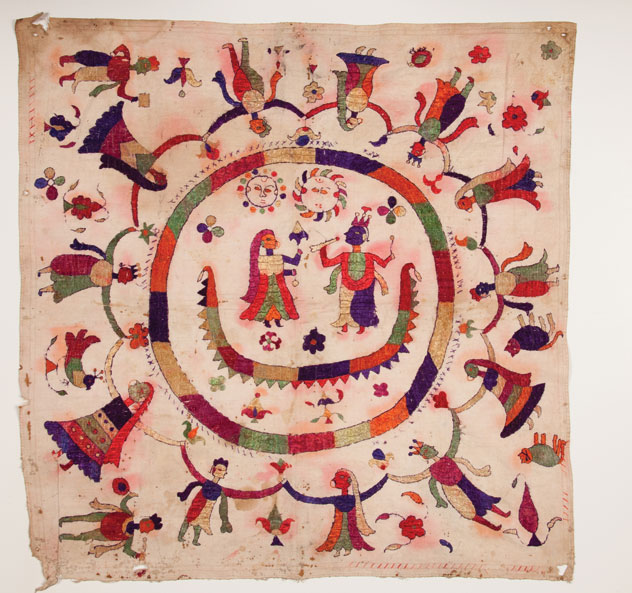
(Above): Chamba Rumal, showing the Raas Lila — the dance of the cowherd Lord Krishna with the gopis or cow girl herders — 20th Century Chamba — Cotton, silk embroidery — 21.5” x 21.5”. [Photo: San Jose Museum of Quilts & Textiles]
The Museum of Quilts & Textiles is located at 520 South First Street, San Jose, Calif. For more information, call (408) 971-0323 or visit sjquiltmuseum.org.
This exhibition and related programming are funded in part by Connie and Eric Tiegel, Terumi Irizawa, and Moda/United Notions and Tavant Technologies, Inc.; the David and Lucile Packard Foundation; Arts Council Silicon Valley in partnership with the County of Santa Clara; the City of San Jose; and the Santa Clara Valley Quilt Association.
|